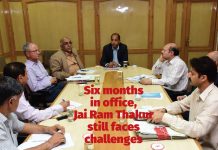Well aware of the crucial role the migrants play in various industry sectors in the state, the TN administration swung into action after the videos stoked safety fears among them. CM Stalin personally met with some of the guest workers to boost their confidence, writes Aayush Goel
Yet another fake video hit headlines recently. This video shared by an enthusiastic You Tuber showed migrant labourers being beaten up brutally in Tamil Nadu and even triggered rumours that the two had lost their lives. Shared by a channel named ‘BNR News Reporter Honey’, this video was rolled out with a description that it was “imaginary“. After being forwarded multiple times and going viral it not only created a buzz on social media but also brought the two states of Tamil Nadu and Bihar on their toes.
The video snowballed into a major controversy as the Bihar CM Nitish Kumar tweeted expressing his concern over an incident in Tamil Nadu where two Bihar labourers “lost” their lives. Videos of migrant workers rushing to railway stations to flee the state too started going viral. The Tamil Nadu government realised this could spin out of control, and reached out to the migrants and acted against those spreading the rumours.
Tamil Nadu Chief minister MK Stalin who was initially on back foot, accused BJP members from north Indian states of spreading ‘fake news’ – about the alleged assault on Bihari migrant workers. He alleged that the fake video came a day after he called on the opposition to unite against the ruling BJP before the 2024 general elections. So an alleged attempt by some to gain popularity and viewers not just rattled the two states but has yet again drawn attention to dynamics of migration for states like Tamil Nadu.
The video in question
In this viral video, a man was reportedly seen abusing and assaulting three migrant workers on a moving train in Tamil Nadu. Shortly after the video went viral, the Tamil Nadu railway police registered a case under sections 153 A, 323, and 294 (B) of the IPC in relation to the episode and are on the lookout for the alleged assaulter. The two-minute-long video showed the man asking one of the travellers if he was ‘Tamil or Hindi’, following which he lashed out at him and a couple of other co-passengers. He continued assaulting his fellow passengers, accusing the migrant workers of stealing away local people’s jobs in Tamil Nadu despite repeated calls to stop.
Tamil Nadu in action mode
The local police swung into action after the video went viral and have so far registered 11 cases and arrested three persons for spreading rumours on the safety of migrant workers in Tamil Nadu. “This issue created unrest and is being dealt with top priority. Special teams of the Tamil Nadu police were also camping in places including Delhi, Bhopal, Bihar and Patna to arrest people who circulated fake news in the state,” said Director General of Police C. Sylendra Babu. Amongst those booked are Tamil Nadu BJP chief K Annamalai, two journalists of a Hindi daily and Bihar BJP spokesperson Prashant Patel Umrao. Annamalai retaliated and in a series of tweets he shared a video. He dubbed the case against him as ‘false’ and dared the police to arrest him. Reaching out to the migrant workers community in Tamil Nadu, Chief Minister MK Stalin interacted with a group of labourers to enquire about their well-being. Acting swiftly, the Tamil Nadu government took steps to guarantee the safety of migrant workers in the state. According to a notification issued by the government, a new website (www.labour.tn.gov.in/ism/) has been created to protect migrant workers. Additionally, the government held meetings for workers in all districts, including rural areas.
Fake videos affecting industry
While authorities and leaders are out saying all is well in state, the industrialists are a worried lot. Though the fake videos did not trigger any large-scale exodus of migrant workers in the construction sector, the percentage of workers who left for their native states this Holi was high as compared to last year, said the realtors. Even the Bihar and Tamil Nadu authorities insist they are on annual Holi break but industrialists are keeping their fingers crossed till they return. K Baskaran, secretary of the Kakkalur Industrial Estate Manufacturers Association (KIEMA) said, “They have left and every single industry is in fear till they return. We know videos are fake but they did create panic in them”.
M. Ravi, President, Chennai Hotels Association, said, “Some of my workers have also left for their hometowns after getting calls from their families. We are in touch with them. The migrant workers have played a crucial role in the restaurant and hospitality sector in the state. They learn our language and recipes quickly,” he said. Builders and developer associations in Tamil Nadu have taken real videos to counter the fake video campaign against guest workers in the state. As part of the confidence building measures among the guest workers, construction sites have been restricted to unauthorised entry of outsiders. Further, the workers are being briefed about the ground reality by developers and officials from the labour and police departments.
Builders Association of India’s state municipal and DTCP committee chairman S Ramaprabhu said construction guest workers are facilitated with video calls to their peer groups. “In fact, we have urged them to contact anyone of their choice from the guest workers community to get first-hand information on their own”, he said.
Tamil Nadu: From migrant source to destination
Chennai is a destination for four percent of the inter-state migrants in this country. Historically, Tamil Nadu used to be the source of migrant workers, mainly to Karnataka and Kerala, and Andhra Pradesh. However, with increased industrialisation and urbanisation, the state evolved from migrant source to destination. According to CREDAI, Tamil Nadu, the migrant community oversees 85% of the work in big projects and 70% in medium-scale projects in the state. It also has a visible presence in manufacturing, textiles, construction, and hospitality. A Tamil Nadu Labour Department survey in 2015 estimated that the State had around 11.5 lakh migrant workers.
Migrants vulnerable but have no choice
The fake video episode aside, the situation of migrants in Tamil Nadu has become a topic of discussion. Hundreds of thousands of these migrant workers are concentrated in low-paying jobs without any social safety net in the manufacturing and service sectors. Nevertheless, such informal employment is comparatively attractive to workers who have very little access to most forms of livelihood in their home states. “Who wants to leave one’s home but Bihar still has nothing for us. We are not educated and can only work as labourers. In Chennai, we are paid Rs 400 to Rs 800 per day as compared merely Rs 100 in Bihar. We keep our heads down and work. Yes, we are not treated equal to a Tamil worker but we have to adjust for our families,” says Santosh Kumar, a labourer from Chennai.
These migrant labourers have still not been able to organise themselves to press demand for hike in wages, social security or adequate working conditions. While things are not great and Bihar seems to have changed over years, one wonders what forces lakhs of these workers to leave Bihar for Tamil Nadu in search of livelihood. The enormity of the issue was highlighted when over 15 lakh workers ran helter-skelter to get home during the 2020 Covid-19 pandemic.
Bihar, despite all the big promises by the state leaders, is still among the states most severely affected by unemployment in the country. According to data from the Centre for Monitoring Indian Economy (CMIE), Bihar’s unemployment rate in February 2023 rose to 12.3 per cent, while the national figure was 7.5 per cent.
However, states such as Haryana, Rajasthan and Jharkhand fared worse than Bihar. In 2005, the poverty rate in Bihar was 54.5 per cent. It was the poorest state in the country and maintains the status quo till date. The poverty rate is 51.9 per cent at present. As per a NITI Aayog report, over half of Bihar’s population is multidimensionally poor.












